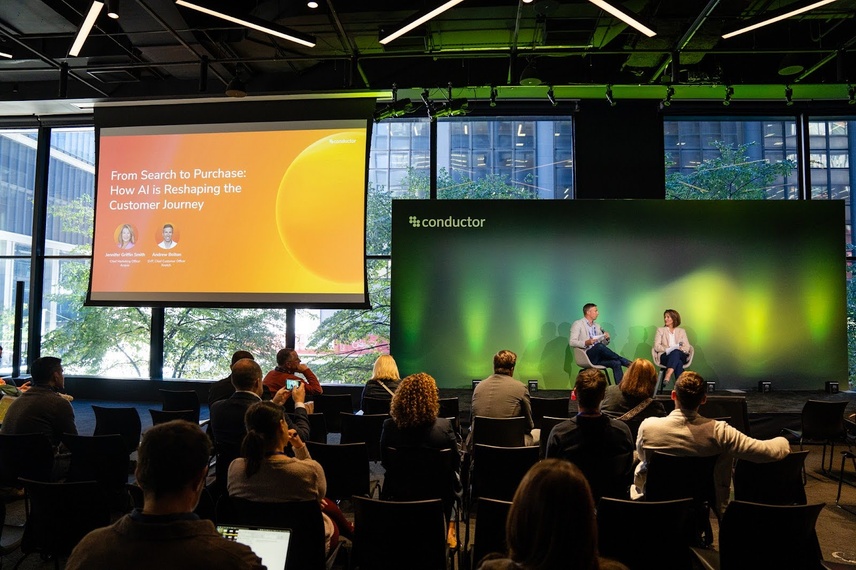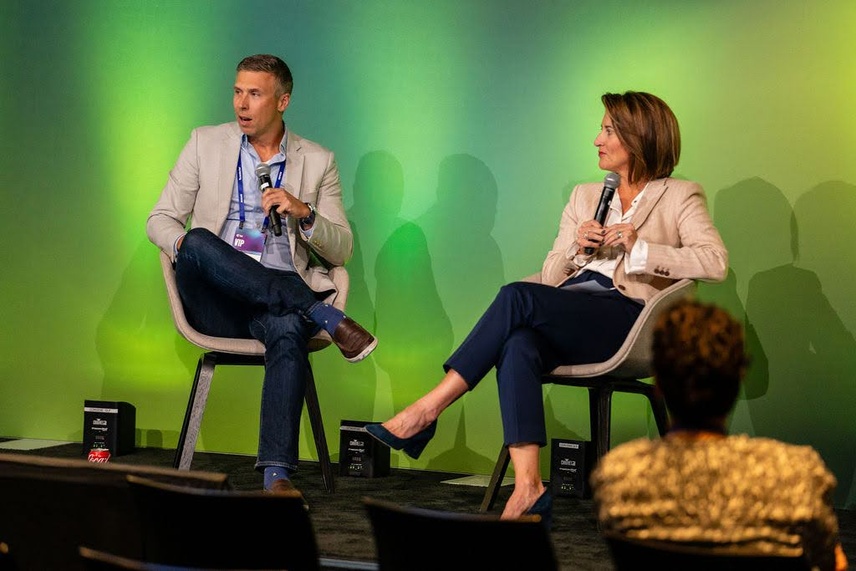A CMO’s Guide to the New AI Customer Journey
- Thought Leadership
- By Conor Baker
- 18 minutes read
Hear from marketing leaders at Acquia and Knotch on navigating the new AI-driven customer journey and how brands should pivot their content strategy.
AI and LLMs are completely reshaping the digital landscape and, with it, the customer journey. For marketers, this represents a fundamental shift in how audiences discover, research, and connect with brands.
In this fireside chat from C3 2025, New York’s premier AEO / GEO conference, brought to you by Conductor, Jennifer Griffin Smith, Chief Market Officer at Acquia , and Andrew Bolton, SVP and Chief Customer Officer at Knotch , offer forward-thinking perspectives on how to adapt your content strategy, prove AI's value beyond cost-cutting, and build a cohesive digital experience for the AI-primed customer.
These are their top insights:
- The customer journey has changed: Traditional linear funnels are obsolete. Customers now engage with multiple touchpoints across channels in non-linear ways, requiring full-funnel visibility.
- LLM traffic is less predictable: Users arriving from AI-powered search take less predictable journeys than traditional SEO traffic. While it still represents a relatively small piece of overall traffic, understanding these non-linear paths is critical.
- LLM traffic converts faster: Users coming from LLMs are further along in their journey and convert at higher rates—about twice the rate of other site traffic and in about half as many sessions.
- Content must prove its worth: Every piece of content—from brand stories to product pages—needs to demonstrate measurable impact on the customer journey and business outcomes.
- Shift the executive conversation: Reframe AI discussions from cost-cutting to growth and productivity. A 10% increase in growth beats a 20% reduction in costs every time.
- Unified strategy wins: Break down silos between SEO, content, and experience teams. Success requires connecting visibility data with journey analytics and content performance.

How AI search has fundamentally changed the CMO’s role
Andrew Bolton: What we really wanted to dig into today is how AI and LLMs are reshaping the customer journey, going beyond visibility to what's actually helping pull customers through to the actions that drive the business—conversions, subscriptions, and purchases.
It's a unique convergence of technologies: Conductor leads in visibility and understanding around LLM and SEO; Knotch focuses on how content impacts the overall customer journey and moves people through it; and Acquia helps you curate, manage, and deliver those digital experiences.
How has your role as CMO fundamentally changed, especially managing different stakeholders internally in a technology company like Acquia?
Jennifer Griffin Smith: My job's really fun because I get to run marketing at Acquia while also being part of a technology company that's building the technology marketers use. I have the opportunity to speak with marketing leaders at our customers’ organizations who span all different sizes and industries.
I've been in tech marketing my entire career, and today is more exciting than ever in this space because there's so much we can know about our customers and their digital journey. AI is, however, "the wolf at the door." It's fierce, it's dangerous, it's powerful—and it's already in our house. How do we become friends with the wolf and make it our competitive advantage?
Not everybody in our organization, or students graduating, has the experience yet. All of this means a changing world for the CMO and all digital marketing leaders.
Boards—whether you're private or publicly held—are all going to ask about AI.
[AI] is definitely on the board's agenda. There are many digital marketing advancements of the past, like social media, that boards couldn’t care less about. AI is different.

Reframing the AI conversation: From efficiency to growth
Andrew Bolton: One thing we hear when speaking with CMOs is that the word “efficiency” comes up a lot, which is probably the CFO's code word for cost-cutting, which is not great.
How have you reframed the conversation at Acquia, and how have you seen other companies navigate that?
Jennifer Griffin Smith: It's true. When I say it's a board agenda, it's because AI equals cost-cutting in most people's minds. That's generally what they think—how many heads can you reduce and how much spend can you cut because you can now be more productive across every team?
I would take a 10% growth over a 20% reduction in cost, and so would every board and every C-level that you talk to.
The key is turning it into a productivity conversation. Use tools like Conductor to talk about hours saved, then translate that into new content created and high-level KPIs about the customer journey. Show how this impacts the entire funnel—from awareness to conversion. Show how hours saved = improved customer journey = higher conversion rates = improved pipeline and win rate = increased revenue. When you frame it this way, you're having a growth discussion, not a cost discussion.
Andrew Bolton: That's exactly right. Part of what we're doing from a technology perspective is helping CMOs translate how LLMs and AI are actually contributing to business outcomes—not just cutting costs, but driving growth and revenue.
Understand the new path to conversion
Andrew Bolton: We've seen shifts in behaviors over the years, whether it was the advent of SEO and then social, mobile, apps—behavior evolves, and we're seeing that as well. As a result, the importance of the website is changing.
A few data points that are really interesting when we think about how LLMs are shifting people's behavior on a website. Part of what we do at Knotch is look at these long-tail customer journeys over multiple sessions to understand what's nurturing people through.
What we've seen is that people who convert directly from an LLM by clicking on a citation convert at about twice the rate as other site traffic. That means they're more activated when coming to the site this way.
People coming from LLMs take less predictable journeys. They're consuming pages all over the place, which means as a marketer, you have to really think about: How is every page designed to convert to take advantage of this AI-primed audience?
Another interesting piece is that the speed of conversion is a lot faster. They convert in about a third of the time as other sources and about half as many sessions. So if the average time to conversion is five sessions, they're doing it in about two and a half sessions. That means you have this very activated audience coming to your site with a different expectation than other visitors.
What have you been seeing in the data on your site, and how have you been meeting that?
Jennifer Griffin Smith: Thanks to Knotch, we have the data. In the last quarter, my SEO traffic declined 13%, but my LLM traffic increased 22%.
SEO traffic still makes up a much larger percentage of traffic than LLM traffic. However, LLM traffic converts at about 10% compared to other traffic, which is around 2.6%. So I'm saying to my team: LLM traffic converts better. How can we get more of it? Where do we spend our time there? What content do we need for LLMs?
The other interesting thing is the performance of our Acquia TV. acquia.com is our main site, a classic website with all kinds of content. We built Acquia TV, our very own Netflix, our always-on TV channel. It's pure video content.
Through the analysis we can do with Knotch, the traffic on Acquia TV from LLMs converts at twice the rate of the acquia.com site. So, not only is LLS traffic converting better, but traffic to our video channel from an LLM is also even higher. That tells me that video content is even more successful in conversion.
Andrew Bolton: We've seen this across a few other clients. If you think about this new primed audience coming to the site, you would think they're ready to convert—they'll go to more lower-funnel content and product pages and then convert right away.
But it's actually the opposite in many cases, and is similar to you, where they're actually consuming video content and going to more upper-funnel brand content because they've done the nitty-gritty research in the LLM. But they want to validate and learn more about the brand and have that emotional connection, whether B2B or B2C, before they're ready to take action. It's just another tweak in customer behavior that LLMs are responding to.
Balancing AEO / GEO for robots and humans
Andrew Bolton: One thing we've seen for clients across the board is this rush to optimize. We think about it as the robot audience and the human audience, because you have to appeal to both.
We've had clients who went really hard on optimizing for LLM and inadvertently tanked on-site performance, and some people have indexed the other way.
How have you navigated that and worked with the team to create an audience-first, audience-focused approach?
Jennifer Griffin Smith: We haven't perfected it—and, as we've heard over and over again—nobody's perfected it. We’re lucky to have an accessibility tool, too. One thing I say about all of this content is that there are so many ways to make content productive for different audiences, whether that be a bot, a human, or a human with disability needs.
If someone is using a screen reader, any PDF that isn't remediated can’t be read. Creating content on your site goes beyond just creating it for one source. We have to think about all those sources. More often than not, when you create and optimize content for accessibility considerations, it helps LLMs read the content too. It's a much broader strategy rather than just focusing on one area.
Gartner stated that you lose 17% of your traffic if your site isn't accessible. I'd ask how many of you know what your site accessibility rating is? Because it should be over 85%.
If you ran a scan to see what your site's accessibility is, you'd probably be quite shocked. But think about how you could be losing 17% of your traffic because of that. That's outside of even LLMs. There has to be a much broader strategy in place.
Breaking down silos for integrated measurement
Andrew Bolton: One common theme across many brands is the breaking down of traditional silos. You can't just be responsible for driving traffic anymore, and you can't just be responsible for on-site performance. Everything has to have a much more integrated approach, and technology can help enable that.
Talk us through the tech stack a bit—how you're thinking about it and how it serves that more closed-loop foundation.
Jennifer Griffin Smith: We recently surveyed about 500 digital marketing decision makers in the UK and the US about AI and AEO readiness. It was fascinating that 70% said AI would be fundamental to their digital marketing strategy, but only 20% were actually doing anything about it. And 18% said they weren't even thinking about it at all, which is scary.
When we asked them what the blockers were, about 45% said budget, and 40% said lack of internal skills. The answer is that you can use tools to train the internal skills. I love that my team is excited about AI, not because it's going to take their job away, but because it's going to make them better.
These tools—like Conductor and Knotch integrated with a CMS—enable them to be more productive. Now they're excited about thinking, "How can I be the hero and do more?" because the tools can help. ChatGPT can be used as a training tool for anything. We can use these tools to help train our teams and connect everything so we're not just measuring one part of our site, but have a full journey overview.
Andrew Bolton: How have you approached that from a team structure and measurement perspective? I think there are a lot of people who were in a silo, saying, "My job is to do X, and my KPI is Y," and that doesn't happen anymore.
Jennifer Griffin Smith: We allocated one full headcount from our web development team, who is purely focused on AI initiatives in marketing. She looks at what systems we have, how they're being used, how people are trained, what people want to measure, and then runs a full KPI audit: What are we measuring now, and what do we really want to get from the measurement? She also assesses tool usage across the team.
We really needed that dedicated focus because we found we had a lot of point solutions. Salesforce has AI. Whatever piece of tech you have in your martech stack has some part of AI in it. But for me, it was about connecting the dots.
The website of the future is going to be massively different from what it is today. I ultimately don't think homepages will exist. We're just going to be curating content that gets served up through all these channels and search engines.
Andrew Bolton: From a technology perspective, we also capture qualitative feedback and audience sentiment to understand whether the content is achieving a value exchange with the audience. If we're working with a very thought leadership-oriented client, we may bias our measurement more towards engagement and audience sentiment.
However, we still want to keep the audience journey tracked because upper funnel content can still be linked to conversions. Even if that journey takes three to six months, we can see that connection.
Overcoming the silo mindset: A leadership challenge
Andrew Bolton: From a leadership perspective, what did you have to overcome to help people move from the mindset of, "I have my isolated view in my little world, and this is what I'm really focused on," to being more focused on that full journey, and how do you connect it to the end results?
Jennifer Griffin Smith: You have to inspire them with what's possible through AI, and they have to want to learn. I believe that the marketing roles of the future will change—we're not going to be hiring these departmental resources. I don't even think they'll exist.
I wish universities taught more about it—I don't think graduates are coming out with the skills they need. My daughter is a student, and I worry she's not getting enough. I worry that my high schooler isn't getting enough on AI either.
Schools need to do more, and we have to advocate for that. But employees also have to want to learn. There are so many sites out there that provide free resources to help your team. One thing we do is run monthly awards where employees are rewarded with the opportunity to attend a specific conference—it gets them excited about how AI can develop their own careers.
What marketers need to know
Andrew Bolton: For the marketers in the room at all different levels, what are some of the key takeaways that you think they should bring back to their organizations coming out of a conference like this?
Jennifer Griffin Smith: This is a senior-level initiative. This is a CMO-level initiative. We have a broad tech stack, and there are many solutions we offer. I get to sit in front of CMOs of our customers today because they need an AI strategy as part of their digital marketing strategy.
So, the first takeaway is that this is a CMO-level initiative—CMOs need to own the AI strategy and be able to report its impact upward to executives and boards.
The second takeaway is that while we've heard a lot about SEO and LLM optimization, understanding the full customer journey is equally critical. You need to know what content drives engagement and what's being consumed throughout the journey.
You have a great term at Knotch—corrosive content. You might look at reports and see high volume and high traffic, but if that content doesn't convert, it's a waste. That's why measuring the full journey matters—it helps you identify what's working and what's wasting resources.
Proving content’s value: Thought leadership and conversions
Andrew Bolton: When we work with content teams and integrated marketing teams, we see teams that have been on this hamster wheel of producing content based on output KPIs. The more teeth you can put around measurement to get into an outcome-driven mindset is incredibly catalyzing across the entire team. You can tie in SEO traffic and how LLM visibility impacts the end business results—it's not just sitting off in its own place.
Jennifer Griffin Smith: It's resurrecting the whole brand story, which I love, because content is now about more than just selling a product, a service, or a feature. It has to be about thought leadership. If you go way back in time, Patagonia is the best example of this as a brand, even before we were all talking about AI and LLMs. Their content isn't based on you buying a fleece. It's based on their sustainability and their love for the environment.
You buy from them because it's something different; therefore, their content is the first thing you'll find on LLMs because their content is cited and full of research, but it's also thought leadership. If we take examples of that, it makes me look at my content every day and say, “Hey, this is pushing a piece of tech, this isn't adding value. We've got to add more value,” then it becomes more visible.
Andrew Bolton: At the end of the day, you have to remember what drives people.
Humans are value-driven creatures and story-driven creatures. As much as we can think about things in a technical perspective to get in front of eyeballs, you have to remember that audience behavior and that value exchange that you have to create to move people through.
It will be different for every brand—whether B2B or B2C—but there's that commonality that you're still selling to a human, at least for the time being. At some point, maybe agents will do it all for us. But for now, it's about the audience.
Audience Q&A
Q: What data are you seeing about content consumption when people come in through LLMs?
Andrew Bolton: We’re seeing people through citations, so it's a small sample size, but it's indicative. We're also using feedback surveys to understand how many people did an AI search but came in indirectly.
The key question is: What content are they consuming? They convert at a higher rate, faster, and in fewer sessions. As a marketer, you'd think they're at the end of their journey and will go straight to a product page.
We’re seeing that the best-performing content is more upper-funnel brand content. They use the LLM to understand where to go, but they still need to learn about the brand and create an emotional connection before taking the next step.
Q: How do you reconcile thought leadership content with conversion KPIs?
Jennifer Griffin Smith: I believe thought leadership and conversion are tied together. "Thought leadership" is a buzzword—it makes you think there's nothing concrete. But the Patagonia example shows that everything they put out drives to a conversion ultimately. The teams that win are the ones who can draw a clear line from content investment to business outcomes. That's the conversation boards want to have, and that's the conversation that protects marketing budgets.
It's like brand marketing versus demand generation. I've always thought they were one and the same. Now we're executing through digital channels where non-human engines are bringing that traffic back to us.
Q: Can you share more about how Acquia TV was built and whether this approach can work in other industries?
Jennifer Griffin Smith: I used to work for a video company, so I'm passionate about video. I don't use YouTube because I want to own the data and am concerned about the cookieless future.
Acquia TV was built with our CMS, Drupal. We use Vimeo as our video provider and run analytics with Knotch. We look at all the content and how we're describing videos. We have AI assistance on top. It's proof that people want to consume video, even in B2B.
In summary
The customer journey in the AI era demands a new playbook. Success requires understanding how AI-powered search is changing discovery patterns, proving content's impact across the entire funnel, and building integrated strategies that connect visibility, journey analytics, and experience delivery.
Marketing leaders who can navigate this shift—and articulate its value to executives—will be positioned to drive meaningful growth in an increasingly complex digital landscape.
Andrew Bolton and Jennifer Griffin Smith shared these insights and more during their C3 2025 session, From Search to Purpose: How AI is Reshaping the Customer Journey—watch the full recording below.
This conversation is derived from a C3 session—New York's premiere AEO / GEO conference—brought to you by Conductor, and has been edited for length and clarity.

![Jennifer Griffin Smith, Chief Market Officer, [object Object]](https://cdn.sanity.io/images/tkl0o0xu/production/a01eaa33c4711cacb8323dbd561a432a6b72d64f-2048x1500.jpg?fit=min&w=100&h=100&dpr=1&q=95)
![Andrew Bolton, SVP, Chief Customer Officer, [object Object]](https://cdn.sanity.io/images/tkl0o0xu/production/0955603fd1d53523fe6b174b851cc9e0323f2875-800x800.jpg?fit=min&w=100&h=100&dpr=1&q=95)






